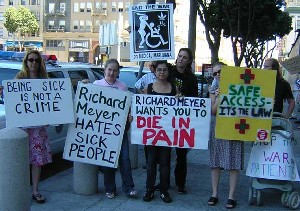Feature:
San
Francisco
Regulates
Medical
Marijuana
Dispensaries
11/25/05
San Francisco, the birthplace of California's medical marijuana movement, has passed an ordinance regulating the city's burgeoning marijuana dispensary scene for the first time. With more than 30 dispensaries currently operating in the city, San Francisco is home to one-fifth of all dispensaries in the state. Now, while almost all currently operating dispensaries will be allowed to stay open, it is going to be more difficult for new ones to open up, and the ones now open will face restrictions on the number of plants they can grow on site and the amount of pot patients can buy.
The regulations approved by the Board of Supervisors last week were championed by Supervisor Ross Mirkarimi, but are substantially less restrictive than Mirkarimi's original ordinance, which would have shut down many of the clubs and imposed record-keeping requirements that some feared could be used against patients and providers by the feds. That put Mirkarimi at odds with pot club operators and Supervisor Chris Daly, who argued that Mirkarimi's original language would have unduly limited access for the city's 8,000 registered medical marijuana patients. But after the board approved a series of amendments, including one that did away with the record-keeping requirement, the new ordinance was passed unanimously and Mirkarimi was loudly applauded in the chamber. Afterwards, he acknowledged the disparate voices and concerns of city residents over the issue and saluted those who worked long and hard to balance the needs of patients, providers, and neighbors. "At times, we've known the city doesn't speak with one voice," he said as the odor of pot smoke drifted through City Hall. "We should all be very, very proud -- you should all be very proud -- in what we were able to achieve today." Under the ordinance, existing dispensaries must apply for licenses from the city and pay license and permit fees. They will also have to meet new health and planning standards. The ordinance limits the amount of marijuana a patient may buy to one ounce, and clubs can grow no more than 24 plants on-scene. Proposed new clubs will have to go through Planning Department public hearings, and cannot be located within 1,000 feet of a school. Existing clubs within 1,000 feet of a school can stay at that location provided there is no marijuana smoking on the premises. "I think this is historic," patient Michael Aldrich told the San Francisco Chronicle after the vote. "San Francisco is the place where the medical marijuana movement started. It's a landmark piece of legislation. I am very proud." "While it's not perfect, it is reasonably good -- as good as we could have hoped for," said MPP's Mirken. "While this city wears its liberalism on its sleeve, it's also the NIMBY capital of the world. It's as if people are saying, 'We love marijuana, but we don't want it moving in next door to us.'"
While San Francisco has only about one-twentieth of California's registered medical marijuana patients, it has one-fifth of the state's dispensaries. "We have 33 or 34 clubs, and most will stay open," said Gieringer. "That's more than enough to cover the city itself, but San Francisco clubs are supplying surrounding cities as well. There will simply have to be more dispensaries in the surrounding area. Oakland is a real problem right now, and they're clamping down outside the city in Alameda County as well." Problems there may be, but the medical marijuana movement that began to sprout when Dennis Peron opened his Market Street club more than a decade ago is now in full bloom. Dispensaries have spread from San Francisco across the state, beginning in Northern California and now reaching even places like San Diego. While different counties and municipalities across the state have approached the issue differently, the San Francisco ordinance may mark the beginning of the "routinization" of the dispensaries in California. "There are at least 160 clubs across the state now," noted Gieringer, "and they are generally operated by entrepreneurial types who not necessarily politically active in the movement like before. Dispensing medical marijuana is becoming a routine business, and an occasional neighborhood nuisance. Regulation is an appropriate way to deal with this." But regulating medical marijuana does not address the larger problem of marijuana prohibition, said Gieringer. "We have between two and three million pot smokers in California, and only a fraction of them are registered medical marijuana users. Recreational users who are well-informed and know about the movement have all gotten medical recommendations -- even though this is not what voters envisioned when the approved Proposition 215 -- but the arrests of pot smokers in California continue. It's the young and the poor and the uninformed who are being arrested."
| |||||||||||||||||||||||||||||||||||||||||||||||||||||||||||||||||||||||||||||||||


